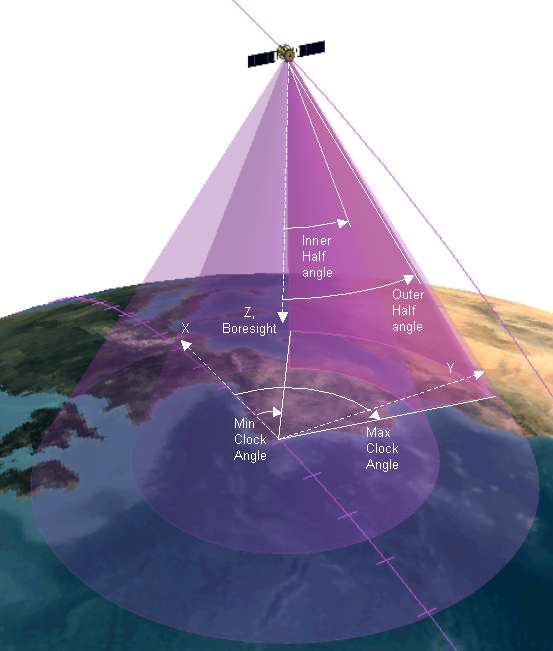ComplexConic Class |
AGI.Foundation.Geometry.ShapesFigure
AGI.Foundation.Geometry.ShapesSolid
AGI.Foundation.Geometry.ShapesSensorFieldOfView
AGI.Foundation.Geometry.ShapesComplexConic
Namespace: AGI.Foundation.Geometry.Shapes
Assembly: AGI.Foundation.Core (in AGI.Foundation.Core.dll) Version: 25.2.423.0 (25.2.423.0)
The ComplexConic type exposes the following members.
| Name | Description | |
|---|---|---|
| ComplexConic |
Constructs a volume with a default definition. Default parameters are: the InnerHalfAngle
equals 0 radians, the OuterHalfAngle equals π/4 radians, the MinimumClockAngle
equals negative π/4 radians, and the MaximumClockAngle equals π/4 radians.
| |
| ComplexConic(Double, Double, Double, Double) |
Constructs a volume of infinite radius with the provided parameters.
| |
| ComplexConic(Double, Double, Double, Double, Double) |
Constructs a volume of limited radius with the provided parameters.
|
| Name | Description | |
|---|---|---|
| InnerHalfAngle |
Gets the inner half angle used to define the interior conical volume of exclusion.
| |
| IsConnected |
Gets a value indicating whether the figure is connected.
(Overrides FigureIsConnected.) | |
| MaximumClockAngle |
Gets the maximum clock angle. In conjunction with MinimumClockAngle, this restricts
volume to only a wedge-shaped portion of the annular cross-section of the sensor cone. The angle is
measured clockwise when looking in the direction of the positive z axis.
| |
| MinimumClockAngle |
Gets the minimum clock angle. In conjunction with MaximumClockAngle, this restricts
volume to only a wedge-shaped portion of the annular cross-section of the sensor cone. The angle is
measured clockwise when looking in the direction of the positive z axis.
| |
| OuterHalfAngle |
Gets the outer half angle used to define the exterior conical boundary of the volume.
| |
| Radius |
Gets or sets the radial limit of the volume. This is the maximum range at which the sensor
can detect a target.
(Inherited from SensorFieldOfView.) |
| Name | Description | |
|---|---|---|
| Encloses |
Indicates if the provided point is inside the volume.
(Overrides SolidEncloses(Cartesian).) | |
| Equals | Determines whether the specified object is equal to the current object. (Inherited from Object.) | |
| Finalize | Allows an object to try to free resources and perform other cleanup operations before it is reclaimed by garbage collection. (Inherited from Object.) | |
| GetEnclosureDescriptions |
Gets the list of descriptions for the enclosure functions for this solid.
(Overrides SolidGetEnclosureDescriptions.) | |
| GetHashCode | Serves as the default hash function. (Inherited from Object.) | |
| GetProjection(Ellipsoid, KinematicTransformation) |
Gets the projection of the sensor onto the front surface of a specified ellipsoid and into space.
(Inherited from SensorFieldOfView.) | |
| GetProjection(Ellipsoid, KinematicTransformation, SensorProjectionOptions) |
Gets the projection of the sensor onto the front surface of a specified ellipsoid and onto a plane at a
specified distance in space.
(Overrides SensorFieldOfViewGetProjection(Ellipsoid, KinematicTransformation, SensorProjectionOptions).) | |
| GetService |
Gets the service object of the specified type.
(Inherited from SensorFieldOfView.) | |
| GetType | Gets the Type of the current instance. (Inherited from Object.) | |
| MemberwiseClone | Creates a shallow copy of the current Object. (Inherited from Object.) | |
| OnRadiusChanged |
Called after the Radius property changes.
(Overrides SensorFieldOfViewOnRadiusChanged.) | |
| SetClockAngles |
Sets the clock angles, which restrict the volume to a wedge-shaped portion of the annular cross-section.
| |
| SetHalfAngles |
Sets the inner and outer half angles of a sensor volume, which are used to define inner and outer
conical volumes.
| |
| ToString | Returns a string that represents the current object. (Inherited from Object.) |
The vertex of the volume is located at the origin and the sensor principal direction is along the positive z-axis. Half angles measured from the principal direction are used to define the outer boundary of the volume as well as an interior conical volume of exclusion. Minimum and maximum clock angles measured from the x-axis and about the principal direction are used to further restrict the volume to a sector of the annular cross-section. The range limit measured radially from the origin defines the maximum distance at which the sensor can detect a target, and forms the final bound of the sensor volume.
